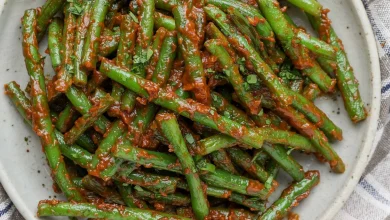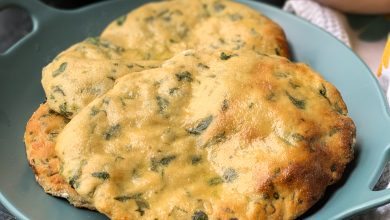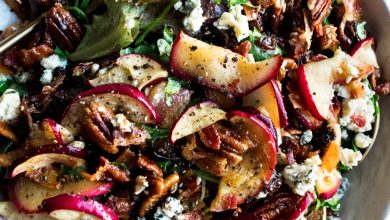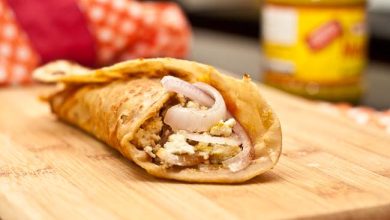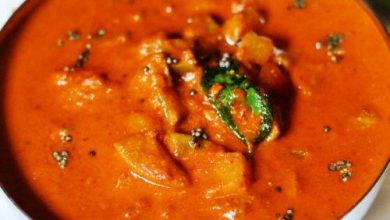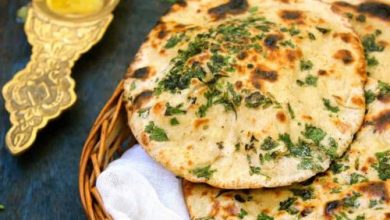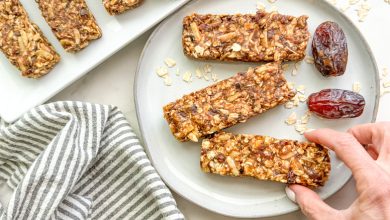Authentic Kerala Appam Recipe – Fermented Rice Pancakes with Coconut
Kerala Style Appam Recipe – Fermented Rice Pancakes with Coconut
Introduction:
Appam is a quintessential dish from Kerala, crafted from a fermented rice batter and typically served with sweetened coconut milk or a hearty vegetable stew. This dish is a favorite for breakfast or dinner and is often enjoyed with a variety of sides such as Kadala Curry or the flavorful Kerala Style Vegetable Stew. The appam is traditionally made in an appa kal (a bowl-shaped pan), which results in a pancake that is thick in the center and thin on the edges, creating a delicate texture that is both soft and crispy.
This Kerala Style Appam Recipe will guide you through the process of preparing this delicious, fermented rice pancake that is perfect for any meal.
Cuisine:
Kerala, India
Course:
Main Course
Diet:
Vegetarian
Ingredients
| Ingredient | Quantity |
|---|---|
| Rice (raw, soaked for 3 hours, such as Ponni rice) | 2 cups |
| Cooked rice | 1 cup |
| Fresh coconut (freshly grated) | 1 cup |
| Active dry yeast | 1 teaspoon |
| Warm water | 1/2 cup |
| Sugar | 2 tablespoons |
| Salt | To taste |
Preparation Time:
200 minutes (Soaking time for rice and fermentation)
Cook Time:
30 minutes
Instructions
-
Soaking the Rice:
- Begin by soaking the raw rice in water for at least 3 to 4 hours. This is essential for achieving the right consistency in your appam batter. You can use Ponni rice or any similar variety of raw rice that works well for fermentation.
-
Proofing the Yeast:
- In a small bowl, combine the warm water with sugar and active dry yeast. Allow the yeast to proof for about 5 minutes. If you’re using instant yeast (which doesn’t require proofing), you can directly add it to the batter later.
-
Grinding the Batter:
- Once the rice has soaked, combine the soaked rice, cooked rice, and freshly grated coconut in a blender or food processor. Add just enough water to help grind the mixture into a thick batter.
- Add the proofed yeast (or the instant yeast) to the batter along with a pinch of salt, and mix well. The batter should be thick but pourable.
-
Fermenting the Batter:
- Transfer the prepared batter into a bowl and cover it. Let it ferment for about 5 to 6 hours, or you can allow it to ferment overnight. This is a crucial step that gives appams their characteristic soft texture.
-
Adjusting the Consistency:
- After fermentation, the batter may have thickened. Gradually add a small amount of water at a time to adjust it to a thick pouring consistency. Be careful not to add too much water, as this could make the batter too thin, affecting the texture and the way the appams cook.
-
Cooking the Appams:
- Preheat your appa chetty (appam pan) or a non-stick frying pan on medium-high heat.
- Once the pan is hot, pour a ladle of batter into the center of the pan and immediately swirl the pan in a circular motion to spread the batter thinly along the sides while keeping the center thicker. This creates the traditional appam shape with a soft, fluffy center and crispy edges.
- Cover the pan with a lid and cook for about 2 minutes. The edges will become golden brown and crispy, while the center will cook through with a steamed, soft texture.
-
Serving:
- Once the appam is cooked, carefully remove it from the pan and serve it hot. Kerala Style Appams are typically enjoyed with Kadala Curry (Black Chickpea Curry) or a flavorful Kerala Style Vegetable Stew, making for a perfect combination of flavors.
Nutritional Information (Approximate values per serving):
| Nutrient | Amount |
|---|---|
| Calories | 150 kcal per appam |
| Protein | 2g |
| Carbohydrates | 30g |
| Fiber | 1g |
| Fat | 1g |
| Sodium | 120mg |
Tips for Perfect Appams:
- Fermentation Time: The fermentation process is key to achieving soft and fluffy appams. If you live in a warm climate, you may only need 5-6 hours for fermentation, but in cooler climates, you may need to leave the batter overnight.
- Consistency of Batter: The batter consistency is crucial. If it’s too watery, the appams may not hold their shape or become too flat. Aim for a thick yet pourable batter.
- Use a Heavy-bottomed Pan: If you don’t have an appa chetty, you can use a regular non-stick frying pan. A heavy-bottomed pan ensures even heat distribution, resulting in crispy edges and a soft center.
Variations:
- Sweetened Coconut Milk: For a traditional Kerala-style breakfast, serve the appams with sweetened coconut milk by blending fresh coconut with water, sugar, and a pinch of cardamom.
- Vegetable Stew: Appams also pair wonderfully with a mild, spiced Kerala-style vegetable stew made from potatoes, carrots, and beans in a coconut milk base.
- Add-Ins: You can add a little bit of fenugreek or cumin seeds to the batter for a slight flavor variation, which enhances the depth of taste.
Conclusion:
Kerala Style Appams are a delightful dish that perfectly encapsulates the flavors and textures of South Indian cuisine. The fermentation process gives the appams a soft center, while the crispy edges make each bite a delicious experience. Whether paired with curry or served with coconut milk, these appams make for a satisfying main course. This recipe is sure to transport your taste buds to the coastal lands of Kerala with every bite!

